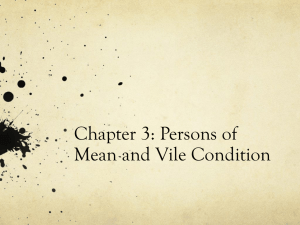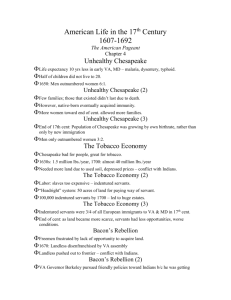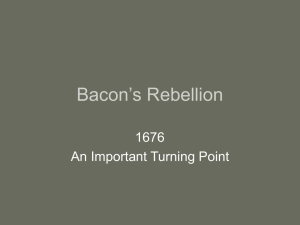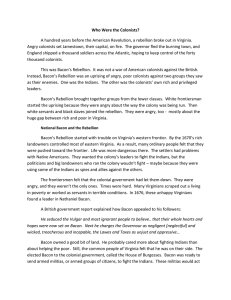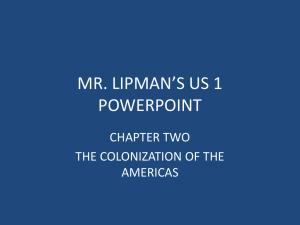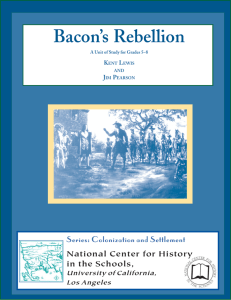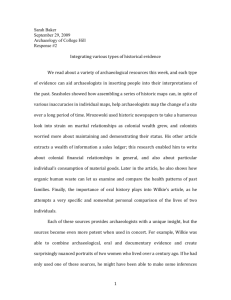Chapter 3: Persons of Mean and Vile Condition
advertisement
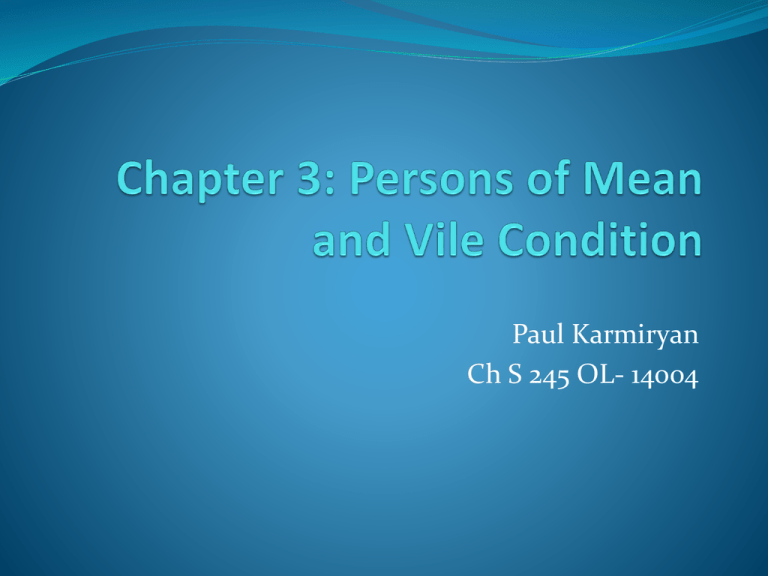
Paul Karmiryan Ch S 245 OL- 14004 Bacon’s Rebellion Nathaniel Bacon began Bacon’s Rebellion in 1676 over how to deal with the Indians who were close by the western frontier. Whites attempted to expand westward, but faced the dilemma of fighting Indians Governor William Berkeley had a more peaceful approach Violence broke on the frontier with the Indians Bacon’s “Declaration of the People” Described the resentment towards the rich Demanded for more protection against Indians on the Western frontier. Bacon dies of illness, and the rebellion ceases to continue New leader, Thomas Grantham attempts to restore order by promising to pardon everyone and disarm rebel forces as the captain of the ship Against the Governor Berkeley argued: “... we cannot but resent, that forty thousand people should be impoverish'd to enrich little more than forty Merchants…” Many Virginians supported the rebellion against the governor Other members of Government Counsel (I.e. Richard Lee) also supported the rebellion Servants of the “miserably poor white underclass” also joined Bacon’s rebellion Servants and Immigrants Poor people coming to America was seen as a commodity of a profit for merchants The biggest profit to be made was by shipping slaves, according to Abbot Smith Immigrants must agree to work for their “master” for 5-7 years upon emigration Trip to America lasted 8-12 weeks under inhuman conditions on ships. Life as a Servant Beatings were common Women servants were often raped 4 out of 5 servants died of disease Laws existed, but were not enforced Rebellion was attempted, but was impractical because of their lack of power Servants could not marry without permission Often not allowed because child bearing would interrupt a women servants ability to serve as a servant A Servant’s Way Out? Many servants ran away: it was easier than rebellion Some ran away with boat, but they were often captured and beaten A number of servants went on strike demanding decent food, but were whipped and the striking stopped US Constitutions held that fugitive servants could not simply hop through states for freedom Maryland’s population consisted of 10% white servants Rare case of free servants became wealthy landowners Abbot Smith argues that they were not given equal opportunity even after they were freed. He states that, “about one in ten was a sound and solid individual” The other 80% were “shifted, hopeless individuals” The Colonies Grow Many English settlers and European immigrants Black slaves were pouring in Shipping and trading expanded overseas Upper class gains the most political power and wealth from the expansion Percentage of poor white males doubled from 14% to 29% The poor struggled to stay alive Unemployment was at a high Severe Food Shortage High prices of food in 1713 led many poor on the streets hungry 200 people riot on the Boston Common Attacked trade ships and warehouses looking for food Wealthy merchants like Andrew Belcher had their ships attacked Many criticized the rich of having oppressed and cheated the poor England in War During the 1730’s, England was fighting a series of wars under Queen Anne’s and King George’s rule This allowed for merchants to get rich Taxes, unemployment and poverty were at a high Seamen rioted in 1747 Indians servants were an obstacle while Black slaves were submissive and easy to control Dangers of slave revolts were high The Threat Many feared that the slaves, Indian servants, and poor would unite and revolt Some doubted this threat as communication was difficult In the North, Blacks and Indians could not meet in large numbers This fear caused consideration of war against Indians This gave rise to a new policy, which later turned into a war The New Policy Laws were passed prohibiting Black slaves in Indian territory because of the fear of revolution This fear was caused by the unity Bacon’s Rebellion instilled upon the people Treaties were made with Indian tribes Indian fugitive servants were freed in exchange Still, the government feared revolution from the Black slaves Blacks were used in the Cherokee War in order to control for this The Middle Class Fights Back The middle class fought against the corruption of the wealthy The New Yorker Cadwallader Golden article attacked wealthy tax dodgers A rich man named James Otis attacks the middle class by stating it is the rich who owns Boston In the Pennsylvania Journal it was stated in 1756 that, “It was ... a middle-class society governed for the most part by its upper classes." References Zinn, Howard. A People's History of the United States. 2005. Print.
